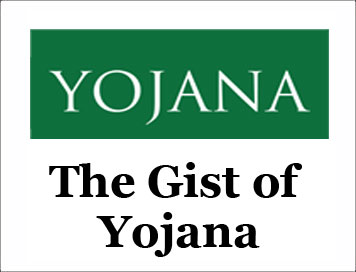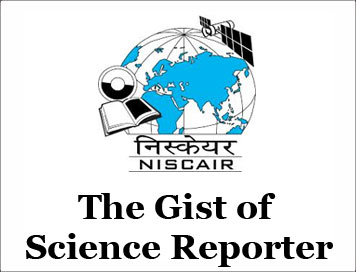
(GIST OF YOJANA) Creating Mass Movement to Address Malnutrition
[MAY-2018]
Creating Mass Movement to Address Malnutrition
It is a known fact that undernutrition is an outcome of not one but multiple
detrimental factors. These factors play their role in helping sustain this
continuous burden of undernutrition leading to our inability to achieve our
desired human resources potential, generation after another. In order to achieve
its true potential and play the role as a global super power India will need to
focus on eradication of malnutrition so as to ensure that the coming generations
are healthy, enabling higher intellectual potential, leading to enhanced work
productivity. This one factor will enable us to connect the dots between schemes
like Make in India, Digital India, Skill India and grow to our desired potential
as a Nation.
On March 8, 2018; the Prime Minister launched POSHAN Abhiyaan – PM’s Overarching
Scheme for Holistic Nourishment from Jhunjhunu in Rajasthan. The programme
through use of technology, a targeted approach and convergence strives to reduce
the level of stunning, under-nutrition, anemia and low birth weight in children,
as also, focus on adolescent girls, pregnant women and lactating mothers, thus
holistically addressing malnutrition. The programme aims to ensure service
delivery and interventions by use of technology, behavioral change through
convergence and lays-down specific targets to be achieved across different
monitoring parameters over the next few years. To ensure a holistic approach,
all 36 States/UTs and districts will be covered in a phased manner i.e. 315
districts in 2017-18, 235 districts in 2018-19 and remaining districts in
2019-20. More than 10 crore people will be benefitted by this programme. Never
before has nutrition got so much prominence at the highest level in the country.
Different Ministries/Departments at the Centre and States/UTs deal with
varied interventions required for reduction of malnutrition in a stand-alone
manner. States/UTs being the highest implementing agency for all such schemes,
it is pertinent to achieve synergy of all interventions to effectively target
malnutrition. POSHAN will provide the required convergence platform for all such
schemes and thus augment a synergized approach toward Nutrition. Convergence at
centre is being achieved through formation of the National Council for Nutrition
and the Executive Committee for POSHAN Abhiyaan. Both these draw members from
all the stakeholders of the Abhiyaan. Similarly, the convergence action plan at
state, district and block level define the implementation and monitoring
mechanisms for the Abhiyaan. The very high speed network (VHSN) day provides the
convergence platform at village level, for participation of all frontline
functionaries.
The problem of malnutrition is inter-generational and is dependent on
multiple factors which, inter-alia, include optimal Infant & Young Child Feeding
(IYCF) practices, Immunization, Institutional Delivery, Early Childhood
Development, Food Fortification, Deworming, access to safe drinking water and
proper sanitation (WASH), Dietary diversification, and other related factors.
Therefore, to address the problem of stunting, under-weight and wasting,
especially in children, there is a need to take-up sustained efforts requiring
multi-pronged approach and bring grass-root synergy and convergence.
Ministry of Women and Child Development is the nodal Ministry for anchoring
overall implementation; as described above, the vision is for all these
Ministries to work together for addressing undernutrition. Never before has so
many programmes been pulled together for addressing undernutrition at national
level in India. The Prime Minister Office will review the progress every six
months and similar review is expected at state level; and this process will be
augmented by nutrition specific review in every district by the District
Magistrate on a quarterly basis every 10‘” January, April, July and October. As
the National Family Health Survey (NFHS-4) highlights that inter-state and
inter-district variability for undernutrition is very high, so every
state/district needs to develop its Convergence Action Plan which includes their
specific constraints and bottlenecks and what can they address in short, mid or
long term. It is very important that we put all the necessary processes in place
before we start expecting miraculous changes in the undernutrition burden across
the country. This Abhiyaan is going to be linked with incentives for the front
line workers like Anganwadi workers for better service delivery, for the team
based incentives for Anganwadi workers, ASHA and ANM for achieving targets
together; and for early achiever states and UTs. For the non-performing states/UTs/
districts/ blocks/ Anganwadi centers there would be focused support and hand
holding to make them start performing better.
Thus, the POSHAN Abhiyaan is to bring all of us together, put accountability
and responsibilities on all stakeholders, to help the Country accomplish its
desired potential in terms of its demographic dividend of 130 Crore human
resource.
Food to Nutrition SecuritySince 1947, achieving food security has been
a major goal of our country. This was because the Bengal Famine created
awareness of the need for paying priority attention to the elimination of
hunger. Our Food Security Act 2013 specially mentions the need for nutritional
security (An Act to provide for food and nutritional security in human life
cycle approach, by ensuring access to adequate quantity of quality food at
affordable prices to people to live a life with dignity and for matters
connected there with or incidental there to).
In 1986, both in my lecture at FAO and in a book on “Global Aspects of Food
Production” I stressed the need for a change in emphasis from food security to
nutrition security. I also defined nutrition security as “physical economic and
social access to balanced diet, clean drinking water, sanitation and primary
healthcare”. Further I stressed the need for a food based approach to nutrition
security and not a drug based one. Now after 30 years, the concept of nutrition
security is gaining ground. MSSRF is planning to demonstrate how agriculture,
health and nutrition can enter into a symbiotic relationship. In the area of
nutrition security, it is important to look at food adequacy, protein deficiency
and deficiency of micronutrients like iron, iodine, zinc, vitamin A etc. The
Farming System for Nutrition (FSN) developed by me provides a methodology for
achieving such symbiotic linkages. Above all, a global grid of genetic gardens
of Biofortified plants will be an important tool for fighting hidden hunger.
National Nutrition Week
It will be worthwhile to spend National Nutrition Week and other such events
in generating awareness of the implications of malnutrition particularly with
reference to brain development in the child. As an action programme, it will be
useful to launch a National Grid of Genetic Garden of Biofortitifed Plants. It
will help us to provide agriculture remedies to major nutrition problems
particularly affecting the poor. These events provide a great opportunity to
launch a programme for the nutritional well being of our population.
Making National Nutrition Mission a Success
Government has approved a National Nutrition Mission with a three year budget
of Rs. 9,000 crore. This is government’s response to the widespread malnutrition
resulting in children with impaired cognitive abilities. The Nutrition Mission
to be successful should be designed on a mission mode with symbiotic interaction
among components and with a Mission Director who has the requisite authority
coupled with accountability. Earlier Missions were not successful because the
concept of the Mission was not fully operationalised. For example the Nutrition
Mission should have the following interactive components to make it a success:
Overcoming undemutn'tion through the effective use of the provisions of the
Food Security Act and also taking advantage of the enlarged food basket which
includes millets in addition to rice and wheat.
Assuring enough protein intake through increased pulses production and increased
consumption of milk and poultry products.
Overcoming the hidden hunger caused by micronutrient malnutrition through the
establishment of genetic gardens of biofortified plants.
Ensuring food quality and safety through steps for the adoption of improved
post-harvest management.




